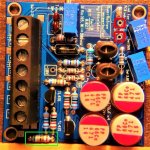It is possible that vias haven't connected between both sides of the board due to manufacturer defect, but this should not be a problem if both sides of the board are soldered to the lead.
At this point I would measure the resistance of all the resistors on-board. It looks to me by your transistor voltages that the Kuartlotron section is fine, and that the problem is in the regulator section.
All my solder connections are solder to the leads on both sides of the boards.
I checked every resistor on the board including the trimmers. Everything is within spec. except the 10K resistors which give a reading that rises. Is this because the they are in circuit with the regs? Also I removed the caps. My DMM only reads capacitance to 200 uF. but charging/discharging test with DMM indicated they are good.
It is not certain that it comes from there but it does not cost anything to test.
With a tester to continue (beep) between the two holes circled in red the measurement must be able to be tested.
🙂
Inductor holes show continuity (beep)
With the transistors, and caps off the board are there any tests I can do with my DMM with the board powered?
@BRN
Have you overcome the problems yet?
If not see post 809 above as one elcap is wrong polarity.
[I posted 809 without ref. as to which builder's picture was involved! 😱]
Have you overcome the problems yet?
If not see post 809 above as one elcap is wrong polarity.
[I posted 809 without ref. as to which builder's picture was involved! 😱]
@BRN
Have you overcome the problems yet?
If not see post 809 above as one elcap is wrong polarity.
[I posted 809 without ref. as to which builder's picture was involved! 😱]
Thanks for the catch. The buffer has played fine. I would have thought that a cap would have gone bad.
I removed the 3.3k, and 10k resistors out of circuit to get correct readings. They are all within spec. So every resistor on the board are ok.
Do you know that the TL431 is still good?
They should be as I swapped them from ones on the good board, and the ones I removed from the bad board are now working on the good board.
I'm beginning to wonder if I should send you a new board.
I just reordered most of the BOM from Mouser, so since half of the board has already been stripped of parts, that might be a good idea rather than putting a bunch of new parts on a questionable board. Yeah - please send me a new board, and PM me the bill.
Thanks,
Lacro
I wanted to know what the current draw of the buffer is for each board. Reading through the forum I saw 12mA each and another with 22mA for both. Is this fairly accurate?
Thanks,
BRN
Thanks,
BRN
I'm not going to use the shunt reg on the board, so is the current draw lower? Also, is 25mA for each board or both boards?
Thanks for the help.
BRN
Thanks for the help.
BRN
I just reordered most of the BOM from Mouser, so since half of the board has already been stripped of parts, that might be a good idea rather than putting a bunch of new parts on a questionable board. Yeah - please send me a new board, and PM me the bill.
Thanks,
Lacro
Received the new board, but didn't use it. With some new parts I was able to get the problem board up and running. The Kuartlotran is sounding great in my system. Thanks for all the help with solving my issues.
Hi kean,
is there any opportunity to scale this buffer up, eg. with MJE15030/31s? I'd like to try it for my Headphones😀
is there any opportunity to scale this buffer up, eg. with MJE15030/31s? I'd like to try it for my Headphones😀
Good to hear Lacro. I wonder what the problem was?
Scaling the buffer up to higher power levels increases thermal distortion, and worsens input impedance. I have experimented with higher current but there always seems to be a large tradeoff. Thermal drift could cause significant offset at the output. Clipping behavior could be very bad for your headphones and your ears. So this kind of design takes some work. I may do some experiments.
Scaling the buffer up to higher power levels increases thermal distortion, and worsens input impedance. I have experimented with higher current but there always seems to be a large tradeoff. Thermal drift could cause significant offset at the output. Clipping behavior could be very bad for your headphones and your ears. So this kind of design takes some work. I may do some experiments.
Hi Kean,
thanks for your reply. It's a pity that it cant be implemented this way, but given the size of Kuartlotron perhaps i can parallel some of them to drive a Moving-coil headphone😉
thanks for your reply. It's a pity that it cant be implemented this way, but given the size of Kuartlotron perhaps i can parallel some of them to drive a Moving-coil headphone😉
- Home
- Source & Line
- Analog Line Level
- The Kuartlotron - keantoken's simple error-correction superbuffer
